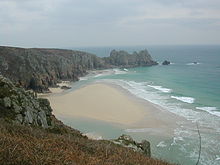Logan Rock
[2] The rock is a ninety-ton granite boulder perched on the edge of the cliffs overlooking the English Channel, on a headland one mile south of Treen.
The area is within the Treen Cliff Site of Special Scientific Interest (SSSI), notified in 1951 for its marine heathland and rare plants.
[4] It is within the Cornwall Area of Outstanding Natural Beauty (AONB),[5] the Penwith Heritage Coast[6] and is owned and managed by the National Trust.
Bray, writing in 1832, notes the expression 'to log the child's cradle' in relation to logan stone as an example of ancient British dialect recorded on Dartmoor in Devon.
To log is a verb in general use throughout Cornwall for vibrating or rolling like a drunken man; and is frequently heard in provincial pronunciation for tug, characteristic of the modern present participle.
It should also be noted that the name for rocking stones could be a modified form of the Danish word "logre," which means 'to wag the tail,' and this suggests possible Norse origin.
For example, Modred, in William Mason's dramatic poem "Caractacus," addressing the characters Vellinus and Elidurus, says of the Logan Rock: Thither, youths, Turn your astonish'd eyes; behold yon huge And unhewn sphere of living adamant, Which, poised by magic, rests its central weight On yonder pointed rock: firm as it seems, Such is the strange and virtuous property, It moves obsequious to the gentlest touch Of him whose breast is pure; but to a traitor, Tho' ev'n a giant's prowess nerv’d his arm, It stands as fixt as Snowdon.
(nephew of the poet Oliver Goldsmith), and ten or twelve of his crew of the cutter HMS Nimble, armed with bars and levers rocked the huge granite boulder until it fell from its cliff-top perch.
Goldsmith was apparently motivated to disprove the claim of Dr Borlase, who wrote in Antiquities of Cornwall in 1754 that: In the parish of S. Levan, there is a promontory called Castle Treryn.
On the western side of the middle group near the top, lies a very large stone, so evenly, poised that any hand may move it to and fro; but the extremities of its base are at such a distance from each other, and so well secured by their nearness to the stone which it stretches itself upon, that it is morally impossible that any lever, or indeed force, however applied in a mechanical way, can remove it from its present situation.Goldsmith was determined to demonstrate that nothing was impossible when the courage and skill of British seamen were engaged.
The local residents demanded that the British Admiralty strip Lieutenant Goldsmith of his Royal Navy commission unless he restored the boulder to its previous position at his own expense.
[13] Francis Kilvert on his visit on 27 July 1870: At the foot of the steep rock on which the Logan Stone is balanced a man stood ready to show the way up, and when he saw me coming he began to run up just like a monkey.
[14]Nonetheless, local historian Craig Weatherhill asserts that a series of rhythmic heaves against the south-western corner of the rock will set it moving, after which, the motion can be kept going with the efforts of one hand.
[17] Inglis Gundry wrote an opera called The Logan Rock which was premiered at the Minack Theatre in 1956 with Edith Coates singing and Marcus Dods conducting.





